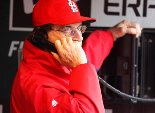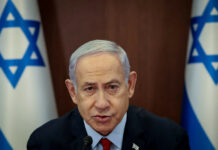 A New York Times report: The seed-strewn dugouts of baseball stadiums around the country may very well end up the final bastions of corded communication in this wireless era.
A New York Times report: The seed-strewn dugouts of baseball stadiums around the country may very well end up the final bastions of corded communication in this wireless era.
While landlines in homes collect dust and serve increasingly decorative functions, the attitude among baseball clubs is a familiar one in a sport tied tightly to old-fashioned ways: why change what works?
“The same old phones, the same old process,” said Derek Lilliquist, the bullpen coach of the St. Louis Cardinals. “I guess they’ve been that way forever.”
Dugout phones have become key instruments during postseason games this October, which have featured managers making bullpen calls with the frequency of telemarketers. In the first two games of the World Series, there have been 16 appearances by relievers even though both games were low-scoring – 3-2 for the Cardinals in Game 1, 2-1 for the Texas Rangers in Game 2. Thus far, all those calls to the bullpen have gone through without a hitch.
But every now and then, over the course of a long season, problems can arise.
Lance Lynn, a Cardinals relief pitcher, recalled a game earlier this season in Philadelphia, when a complex technical issue forced the Cardinals’ dugout to lose communication with the bullpen.
“Somebody didn’t put the phone back on the hook all the way, so it wouldn’t ring through,” Lynn said, laughing.
Manager Tony La Russa had to send Jaime Garcia, a young starter, across the field between innings to relay instructions to the relievers about who needed to get warmed up – and to tell them to put the phone down properly. “And that was a long run, too,” Lynn said.
When the phone lines went dead during a Mets game late this summer, Manager Terry Collins was forced to use a combination of hand signals and towel-waving to convey which pitchers he wanted to start throwing.
And then there are more deliberate malfunctions. In 2003, Eric Gagne, then the closer for the Los Angeles Dodgers, made the dugout phone at Pac Bell Park in San Francisco an outlet for his frustrations, snapping the cord in half while swiping at the receiver and in the process earning himself a $500 repair bill from the Giants.
“You have technical foul-ups,” La Russa said. “That’s why I limit my technical exploits to paper and pencil.”
La Russa, in particular, has been racking up minutes on the phone. A relentless strategist, he has used 10 relievers through Games 1 and 2 after adroitly using an army of them in the first two rounds of the postseason.
Last week, he was asked for his opinion of the dugout phones in Busch Stadium. In St. Louis, there are two phones per dugout: one dials directly to the bullpen, the other rings the press box. (Mets fans may remember when Bobby Bonilla dialed the press box during a game at Shea Stadium to complain about being charged with an error on a play.)
The phones, manufactured by Avaya, are secured in black and white shells labeled “telephone” from top to bottom and emit a high-pitched but surprisingly discreet ring. Teams in various stadiums in the past have had issues hearing dugout phones over crowd noise.
La Russa was asked whether he had any complaints about the phones and if he thought the technology could be improved in any way. “Do you work for AT&T?” La Russa said to the reporter, drawing laughter in the room. “No, I never thought about how to make it better.”
But others have. In 2006, the Chicago Cubs and Motorola announced that the company’s i580 wireless phone would be used in the dugouts at Wrigley Field – “ushering in a new era for bullpen phone communication,” according to the news release, which also proclaimed that the phone used in the first game would be sent on to the Hall of Fame in Cooperstown.
One of the phone’s features was that it could clip onto a manager’s belt. But there were issues, too, as Dusty Baker, then the team’s manager, quickly discovered. It only had half-duplex capabilities, meaning that it worked like a walkie-talkie and that only one person could talk at a time. Motorola’s engineers worked with the team and Major League Baseball to remedy the problem, introducing a new phone with full duplex capability, according to Kristine Mulford, a company spokeswoman who worked on the project, but the phone still fell out of favor with the team.
Jason Carr, a Cubs spokesman, said the phone was phased out before the end of the season. And the historic i580 never made it to Cooperstown, according to Sue McKay, the director of collections at the Hall of Fame.
Exactly when dugout phones began to be used in baseball is unclear. The Hall of Fame could not pin down a date; nor could Major League Baseball. A search through the archives of The New York Times found mentions of dugout phones dating at least as far back as the mid-1950s.
The phones have remained largely unchanged for decades, and baseball seems ambivalent about launching any other projects to advance the technology. The few issues that arise each year have not prompted baseball officials to review the matter. According Peter Woodfork, a senior vice president for operations with Major League Baseball, the only regulation is that the phones remain a single line that connects the dugout to the bullpen, with no outside calling capability.
“We’re not against them,” Woodfork said of new phones. “What we want to avoid is a situation where the communication allows one team an advantage. I think as long as it’s one line, if someone had a different device, we’d look into it.”
And as some players noted, the introduction of mobile phones could bring a new set of issues, like the dreaded “Can you hear me now?” problem.
“With a cellphone, you never know when you might lose your signal,” Lynn said. “I think for now the hard lines are just a little easier to work with.” Especially when Tony La Russa is your manager.
{NY Times/Matzav.com Newscenter}












try to keep to topics that are of interest to us. as you usualy do.